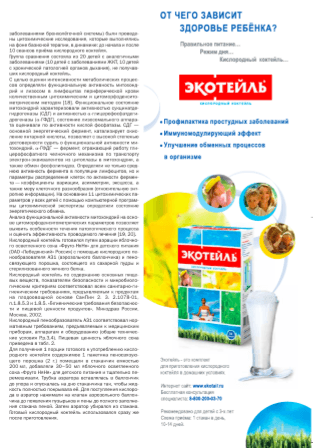It is believed that this drink saturates the body with oxygen and is therefore good for health. We checked whether this is supported by scientific evidence.
They write about it sites medical centers and sanatoriums, and in Media they talk about kindergartens where oxygen cocktails are prepared for pupils. IN some sources, however, not only report the supposed benefits of the drink, but also indicate for the presence of contraindications. At the same time row experts say oxygen cocktails are useless at best. For example, a famous pediatrician Evgeny Komarovsky explains: “This is only useful for parents who reassure themselves in this way, saying, ‘We did everything for our children and their health, we don’t feel sorry for anything.’”
An oxygen cocktail is drink, which is a thick, airy foam that is 80–90% oxygen and can be drunk or eaten with a spoon. In addition to oxygen, the composition includes a flavor base (juice, fruit drink, milk, syrup or herbal infusion), a foaming agent (most often dried egg white, but for people with allergies it can be replaced with licorice root extract), apple pectin, as well as sugar and ascorbic acid to improve the taste and stability of the foam.
Oxygen cocktails invented in 1963, Soviet physiologist Nikolai Sirotinin. The idea arose during research hypoxia - a condition in which the blood carries insufficient oxygen to the body's cells. At that time, enteral oxygen therapy was considered one of the possible treatment methods (the term “intragastric oxygen therapy” is also common in the scientific literature) - the introduction of oxygen into the gastrointestinal tract, because the small and large intestines are capable of absorbing this gas. At first, Sirotinin supplied oxygen to the stomachs of his patients using a probe, but this was very uncomfortable for them, so the scientist chose a less painful option - drinking oxygenated foam. Later, various flavoring additives began to be added to the foam, and oxygen cocktails became an integral part of the spa program. However, outside the USSR, these drinks were not distributed either as medicines or as health benefits.
Although saturating the body with oxygen bypassing the lungs is a very pressing task facing modern science, the stomach can hardly be called a promising candidate organ. There are almost no English-language articles on this topic in scientific citation databases. There are either translated articles by Russian-speaking authors, or research more than 50 years ago, the authors of which come to a conclusion: oxygen absorption in the stomach occurs in insufficient quantities. Moreover, the authors of one of these articles, published in 1963, demonstrated that the use of intragastric oxygen therapy can be dangerous for newborns with hypoxia.
At the same time, many modern Russian-language publications raise a number of questions. For example, in research 2019, conducted at the Kabardino-Balkarian State University, studied how patients with bronchial asthma can benefit from intragastric oxygen therapy and interval hypoxic therapy. However, the article, firstly, does not indicate how oxygen was delivered to the stomach, secondly, the experiment participants were not divided into groups (volunteers were exposed to both methods at once), and thirdly, the scientists do not talk about how exactly intragastric oxygen therapy alleviates asthma symptoms - they simply claim that oxygen helps. Authors of the 2014 article compared therapy of chronic respiratory diseases with and without the use of oxygen cocktails, however, as a measure of effectiveness they chose the severity of symptoms of autonomic dysfunction (that is, vegetative-vascular dystonia, VSD) - pathology, which is not included in the International Classification of Diseases (and the world scientific community considers VSD an outdated diagnosis). The most “outstanding” on this list can be called study, published by specialists of the Scientific Center for Children's Health of the Russian Academy of Medical Sciences in 2007 in the journal “Issues of Modern Pediatrics” - right in the text of the article there is an advertisement for a kit for preparing oxygen cocktails at home.

However, there are more conscientious publications about intragastric oxygen therapy. For example, in 2022, employees of the Russian National Medical Research Center named after Almazov told about a patient whose gastrointestinal tract was injected with oxygen to treat an infection. It was caused by the bacterium Clostridioides difficile, which lives in an oxygen-free environment, so this procedure had an antimicrobial effect. However, in this case we were talking about gaseous oxygen and its delivery through a special probe to the intestines, and not to the stomach, so it would be incorrect to associate these data with the benefits of oxygen cocktails. Similar to this report another — on the inclusion of intragastric oxygen therapy in the treatment protocol for extremely severe influenza in a woman after a cesarean section. Back in 2014, scientists from the same Almazov Center studied case reports of 34 patients who were critically ill due to problems with the respiratory system and concluded that the introduction of oxygen into the intestines reduced the symptoms of hypoxia, but the introduction into the stomach did not.
The data of Russian specialists are consistent with discovery, which was made by Japanese scientists in 2021. During the coronavirus pandemic, amid a shortage of artificial lung ventilation devices (ALVs) and extracorporeal membrane oxygenation (ECMO), researchers from different countries became interested in the method of intestinal breathing, or enteral ventilation through the anus. Japanese scientists were attracted by the loach fish, which practices such breathing in conditions of lack of oxygen. After studying these fish, they tested the effectiveness of two methods of introducing oxygen into the intestines in mice, rats and pigs: pumping gas through the anus and injecting liquid oxygen-carrying perfluorocarbon. The second method turned out to be more effective, and the researchers were able to achieve stable maintenance of gas exchange in experimental animals. However, devices for ventilating the body through the anus, designed to help people, have not yet entered mass production.

Thus, reputable studies do not confirm that drinking oxygen cocktails helps in the treatment or prevention of any diseases. In world science, the introduction of oxygen into the stomach is generally recognized as ineffective. The gastrointestinal tract is capable of taking over the function of the lungs for some time and providing the body with oxygen, but in this case this gas must be introduced into the intestines. It is likely that oxygen cocktails, or more precisely, oxygen-enriched foam, could be effective against hypoxia if it were administered from the other end of the gastrointestinal tract.
Cover image: SGC "Opeka"
If you find a spelling or grammatical error, please let us know by highlighting the error text and clicking Ctrl+Enter.






